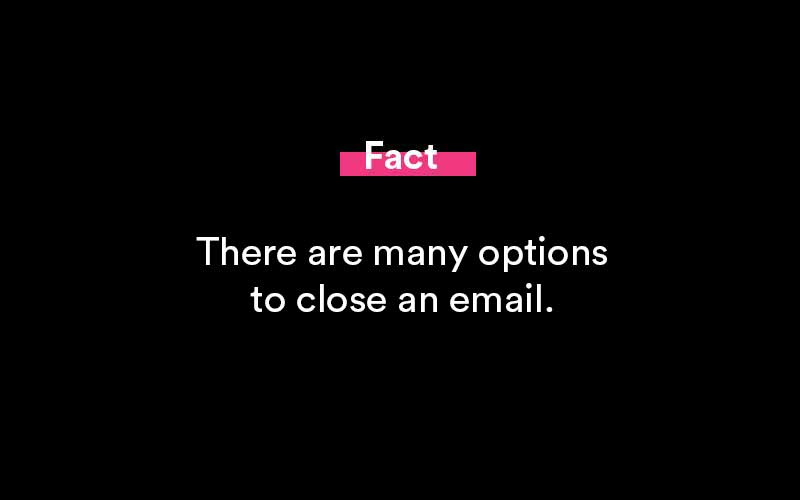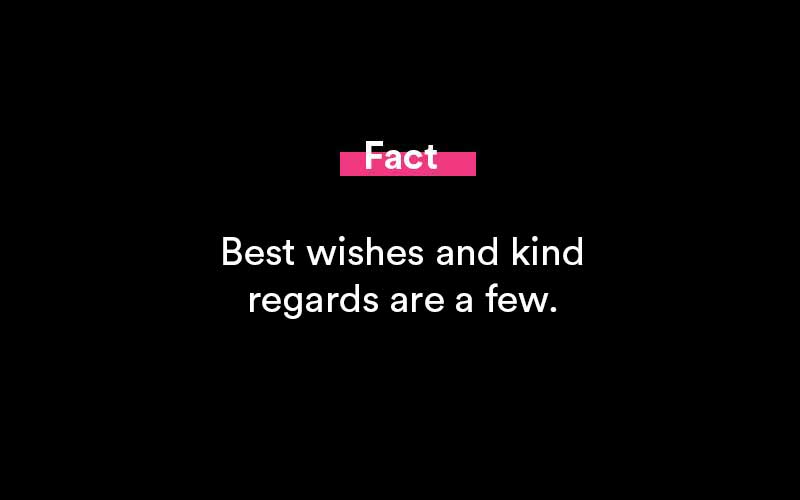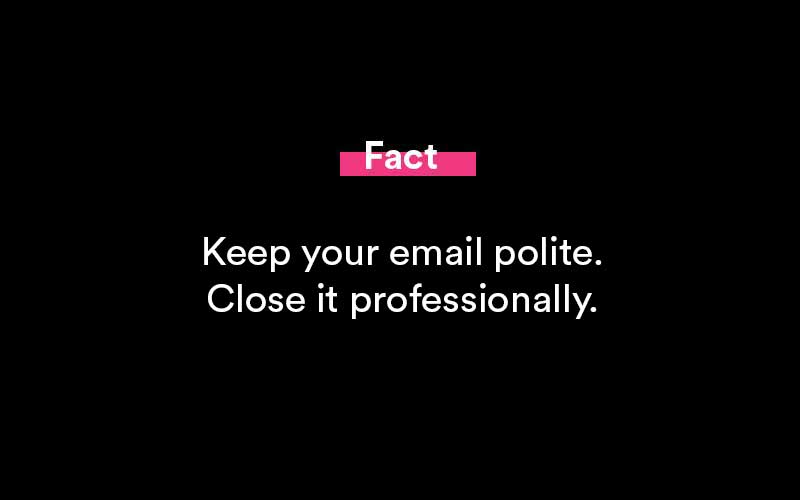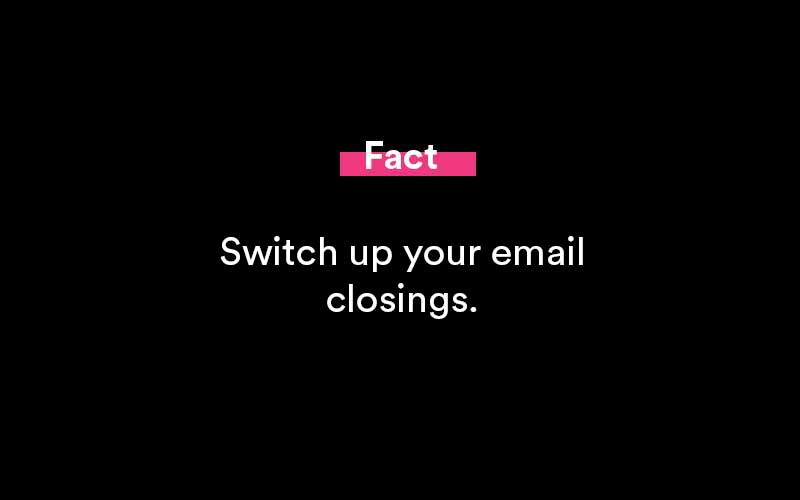Alternatives to "Kind Regards" and "Best Regards"
Kind regards. An overused email sign-off. In the corporate sector, communication often entails formal communication, most notably via email. Before writing your name on emails, it's critical to learn the proper ways to conclude them professionally and adequately. The phrase "best regards" is an efficient approach to end an email, as it is versatile enough to be used in formal and informal correspondence.

What does "kind regards" mean?
"Kind regards" is a little more formal variant of "best wishes" that conveys the same level of respect. When contacting someone to introduce yourself or emailing a supervisor or executive at your company, it is appropriate to use "Best wishes."

Kind regards meaning (in an email)
If receiving an email with the closing "kind regards," it may mean that this email is not coming from a close relationship. And the conversation is between clients, a person you've not met in person, or an intention to become a professional connection. It shows appreciation and consideration for having read the email.
What does the phrase "best regards" mean?
"Best regards" is a frequent, pleasant email and letter closure. When you encounter the phrase "best wishes" near the end of a message, it simply signifies the author wishes you well. It is a semi-formal letter ending that is appropriate for both personal and business correspondence. "Best regards" conveys a sense of respect for the recipient but does not imply a close personal relationship. Additionally, "best wishes," "all the best," and "warmly" are similar closings. "Sincerely" or "respectfully" are more formal closings.
When to use the term "best regards"
"Best wishes" can convey a sense of esteem, familiarity, well-intentioned, and professionalism. Here are a few examples of how you might use the phrase to close an email effectively:
- When communicating with your boss or supervisor about a project.
- When interacting with a client with whom you've formed a professional relationship.
- When interacting with a vendor with whom you've previously worked.
Consider your relationship with the recipient and the message's intent when deciding whether or not to close your email with "best regards." when speaking with coworkers or team members, "Best regards" is most appropriate when you and the recipient have a working connection or have previously communicated. While it gets most frequently used when communicating over email, it can also get used to conclude a physical letter.
Additionally, it can be beneficial to investigate other substitutes for "best regards" and assess whether any of them would be a better fit. After your email, experiment with a range of different sign-offs to find which one fits best with your content.
Alternatives to kind regards and best regards
While the word "best regards" is an appropriate way to finish an email in a variety of settings, both professional and personal, there are many additional alternatives that convey the same concept. Consider the following alternative sign-offs:
Regards
When the word "best regard" is shortened to "regards," it becomes less formal. This is an appropriate option for less formal types of communication, such as conversing casually with a coworker or a personal connection outside of work. Avoid "kindest regards" as it sounds grammatically incorrect.

Best
When contacting someone you communicate with frequently, you may use the adjective "best." this is another abbreviation for "best wishes." While less formal than formal communication, it is an accepted professional communication mode.
Best wishes
"Kind regards" is a little more formal variant of "best wishes" that conveys the same level of respect. When contacting someone to introduce oneself or emailing a supervisor or executive at your firm, it is appropriate to use it.
Sincere regards
"Sincere regards" is a more personal version of "best wishes." It conveys gratitude to the recipient and is particularly acceptable when speaking with people you are acquainted with, such as acquaintances or family members.
If the term "best wishes" does not seem appropriate for the type of communication you are writing, you can use one of the following alternatives:
Respectfully
The term "respectfully" conveys a sense of seriousness and regard for the recipient. It is an acceptable method of communication while speaking with a boss, supervisor, recruiting manager, or professor.
Thank you
This statement is brief and concise, making it an excellent choice if you are unsure of the receiver or the appropriate amount of formality to utilize. When communicating via email, many people use the phrase "thank you."
Thank you in advance
When requesting that the recipient do an action on your behalf, this alternate sign-off communicates your gratitude. It's a beautiful alternative for obtaining additional information or asking a favor from a coworker.
Sincerely
"Sincerely" is an appropriate finish when attempting to convey professionalism without being overly formal or casual. You might use it when composing an email in response to a job application or when exploring the possibility of forming a business partnership.
Appreciate you
Saying "Appreciate you" or "I appreciate it," is a simple way to close personal letters and business letters with those you have a working relationship with or would like a working relationship with. It's a favorable alternative to "Kind regards" and "Best wishes."
Warmest regards
A variation of "Regards." This is great for informal emails, close friends, and business correspondence. Similar expressions are "Dearest regards" and simply "Regards."
Examples of how to use "best regards"
"Best regards" can be used to close a variety of various sorts of communication, particularly those in which you have met or worked with the recipient previously. Here are two examples of business emails that conclude with "best regards."
A semi-formal email example
Here is an example of how to end a semi-professional email to a prospective business partner with "best regards":
Emily,
We appreciate your time yesterday in meeting with my team. We believe that the meeting was really constructive, and we look forward to working with you over the coming few months. Kindly contact us if you or any of your team members have any more queries.
Best wishes,
Ryan
A less formal email example
Here is an example of an email with a coworker that utilizes "best regards" in a less formal manner:
Karen,
I've attached the documents you asked to kick-start the planning process. My team finished all needed drafts, and we look forward to working on this project together. Once you've reviewed the drafts and determined that we're ready to proceed, we may schedule a meeting to discuss the next steps. Please get in touch with me if you have any questions or require any modifications in the interim.
I look forward to collaborating with you on this project.
Best wishes,
Melissa
Is "kind regards" a good email sign-off?
"Regards," "Best wishes," and "Kind regards" are all acceptable email signatures. Remember that about and about can be used interchangeably with, and more briefly than, in regard to and with regard to. The phrases in relation to and with reference to are never accurate, and their use may result in condemnation.
Is "kind regards" rude?
No. There are better closings to use for business letters and emails.
Here's what top writers had to say about using this closing in a professional correspondence:
"If I wanted to maintain a certain level of formality while still appearing friendly, I would prefer "warm regards" or "best regards." Any ending remark less formal than this one, I believe, will speak for itself, as you rarely use informal language when putting someone in their place."
Can you say "kind regards" to a teacher?
Yes. Though, it's best to use a more formal version like "Best wishes" or "Best."
Always conclude by expressing gratitude for the professor's time and ending with "Best wishes" or "Regards" (or some other relatively formal but friendly closing). Additionally, always sign your correspondence with your (complete) legal name, not a nickname..
What is the best email sign-off?
The general rule is to consider all emails formal. Try these closings:
- Regards.
- Sincerely.
- Best wishes.
- Cheers.
- Best.
- Thanks in advance.
- Thank you.
- Thanks.
- Appreciate it.
- Appreciate you.

Popular Resources

Featured
35+ Phone Interview Questions & Best Sample Answers
Phone interviews have become a core part of the process when attempting to find a secured placement for an open position. Companies receive massive responses from potential candidates for any..

Featured
12+ Best Questions To Ask A Recruiter
Concerning a job search, you might receive numerous offers from your recruiters. Before you choose one, you need to assess all the conditions, for which it is vital that you know everything associated with the offered position..

Featured
Answering "What Makes You Unique" In A Job Interview
Answering this question during a job interview requires more than knowing why you are unique as an individual. Yes, the true scientific answer is made up of two main components: your..

Featured
250+ Ice Breaker Questions for Life
An ice breaker question is a question that’s asked from one person to another person in order to act as a conversation starter. It brings a connection...

Featured
10 Best Answers to "What Motivates You?"
Open-ended questions like “What motivates you?” can elicit a deer-in-the-headlights reaction from job candidates if they are unprepared. It’s a broad question and can leave the interviewer..

Featured
Answering "How Did You Hear About This Position" In An Interview
A lot of interviewers ask this question - how did you hear about this position? This way they can judge you if you are a passive or an active job seeker..

Featured
8 Best Thank You Emails After an Interview (Samples, Free Templates)
Writing a thank you note after an interview says a lot about you as a potential employee. Most notably, it says that you care about the opportunities presented..

Featured
Writing a Resignation Letter (How To Write It, Samples)
Writing the perfect letter of resignation is more of an art than it is a science. And we’re going to cover how to master that art form in this full guide..

Featured
How to End a Letter (Example Salutations, Sign Off's)
Knowing how to end a business note or email is an important skill to develop. It helps portray a sense of confidence, respect and tone to your message..
